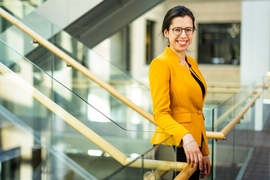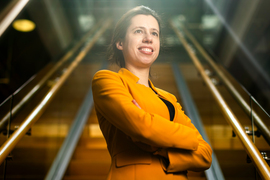As Netta Engelhardt sees it, secrets never die. Not even in a black hole.
Engelhardt is a theoretical physicist at MIT who is teasing out the convoluted physics in and around black holes, in search of the fundamental ingredients that shape our universe. In the process, she’s upending popular ideas in the fields of quantum and gravitational physics.
One of the biggest revelations from her work to date is the way in which information that falls into a black hole can avoid being lost forever. In 2019, shortly before coming to MIT, she and other physicists used gravitational methods to demonstrate that whatever might happen to the information inside a black hole can in principle be undone as the black hole evaporates away.
The team’s conclusion stunned the physics community, as it constituted the most quantitative direct advance toward resolving the longstanding black hole information paradox — a conundrum raised in the work of physicist Stephen Hawking. The paradox pits in opposition two theories that both appear to be true: one, the pillar of “unitarity,” which is the principle that information in the universe is neither created nor destroyed; and two, a calculation by Hawking from standard gravitational physics showing that information can indeed be destroyed, specifically, when radiating out from an evaporating black hole.
“Imagine you had a diary and you set it on fire in the lab,” Engelhardt explains. “According to unitarity, if you knew the fundamental dynamics of the universe, you could take the ashes and reverse-engineer them to see the diary and its contents. It would be very difficult, but you could do it. But Hawking’s calculation shows that, even if you knew the fundamental dynamics of the universe, you still couldn’t reverse-engineer the process of black hole evaporation.”
Engelhardt, then at Princeton University, and her colleagues showed that, contrary to Hawking’s calculation, it is possible to use gravitational physics to see that the process of black hole evaporation does in fact conserve information.
As a newly tenured member of the MIT faculty, Engelhardt is now tackling other longstanding questions about gravity, hoping to fill the last, largest gaps in physicists’ understanding of the universe at the most fundamental scales.
“At the end of the day, I’m driven by questions about nature and how the universe works,” says Engelhardt, who is now an associate professor of physics. “Answering these questions is a vocation.”
Gateway to gravity
Engelhardt was born in Jerusalem, where she developed an early interest in all things science. When she was 9, she and her family moved to Boston, partly so that her mother could enroll in a visiting scholars program in MIT Linguistics. New to America, and having only learned to read in Hebrew, Engelhardt spent those first weeks reading every book the family brought with them, some of them atypical for a 9-year-old.
“I read all the books we had left in Hebrew, until at long last, there was just one left, which was Stephen Hawking’s ‘A Brief History of Time.’”
Hawking’s book was Engelhardt’s first introduction to black holes, the Big Bang, and the fundamental forces and building blocks that shape the universe. What she found especially exciting were the missing pieces to physicists’ understanding.
“People can spend their entire life searching for answers to these very foundational questions that I just found completely fascinating,” Engelhardt says. “Where does the universe come from? What are the fundamental building blocks? Those are questions I realized I just wanted to know the answer to. And from that point on, I wasn’t just set on physics — I was set on quantum gravity at 9.”
She fed that early spark through college, double-majoring in physics and math at Brandeis University. She went on to the University of California at Santa Barbara, where she pursued a PhD in physics and really began to dig into the puzzle of quantum gravity, a field that seeks to describe the effects of gravity according to the principles of quantum mechanics.
The theory of quantum mechanics is a remarkably good blueprint for describing the interactions in nature at the scale of atoms and smaller. These quantum interactions are governed by three of the four fundamental forces that physicists know of. But the fourth force, gravity, has eluded quantum mechanical explanation, particularly in situations where the effect of gravity is overwhelming, such as deep inside black holes.
In such extreme regimes, there is no prediction for how matter and gravity behave. Such a theory would complete physicists’ understanding of the universe’s workings at the most fundamental scales.
For Engelhardt, quantum gravity is also a gateway to other mysterious questions to be answered. For example, the way in which space and time emerge from something even more fundamental. Engelhardt spent much of her graduate work focused on questions about the geometry of spacetime, and how its curvature may emerge from something more basic as described by quantum gravity.
“Those are big questions to tackle,” Engelhardt admits. “The largest bulk of my time is spent thinking, hmm, how do I take this vague intuition and condense it into a question that can be concretely answered, quantitatively? That’s a large part of the progress you can make.”
A black hole imprint
In 2014, midway through her PhD work, Engelhardt honed one of her questions about quantum gravity and spacetime emergence to a specific problem: how to compute the quantum corrections to the entropy of gravitating systems.
“There are surfaces (in spacetime) that are sensitive to gravitational (curving) called extremal surfaces,” Engelhardt explains. “There already was a formula that used such surfaces to compute the entropy of gravitational systems in the absence of quantum effects. But in realistic quantum gravity, there are quantum effects, and I wanted a formula that took that into account.”
She and postdoc Aron Wall worked to construct a general equation that would describe how entropy of gravitating regions should be computed when quantum effects are taken into account. The result: quantum extremal surfaces, a quantum generalization of the old classical surfaces.
At the time, the exercise was purely theoretical, as the quantum effects from most processes in the universe are too small to even slightly wobble the surrounding spacetime. Their new equation, therefore, would land on similar predictions as the purely classical counterpart.
But in 2019, as a postdoc at Princeton, Engelhardt and others realized that this equation might give a very different prediction for what a quantum extremal surface might do, and what the corresponding quantum gravitational entropy would be, in one specific situation: as a black hole evaporates. What’s more, what the equation predicts could be the key to resolving the longstanding black hole information paradox.
“This was a very dramatic moment,” she recalls. “Everyone was working around the clock to try to figure this out, not really sleeping at night because we were so excited.”
After three sleep-deprived weeks, the physicists were convinced that they had made a dramatic step toward resolving the paradox: As a black hole evaporates and releases radiation in a scrambled form of the information that originally fell into it, a new, completely nonclassical quantum extremal surface emerges, resulting in a gravitational entropy that shrinks as more information radiates away. They reasoned that this surface can serve as an imprint of the radiated information, which could in principle be used to reconstruct the original information, which Stephen Hawking had shown would be lost forever.
“That was a Eureka! moment,” she says. “I remember driving home, and thinking, and maybe even saying out loud, ‘I think this is it!’’
It’s not yet clear what Hawking was actually calculating to assume the contrary. But Engelhardt considers the paradox close to resolved, at least in broad strokes, and her team’s work has held up to repeated checks and careful scrutiny. In the meantime, she set her sights on other questions.
Testing pillars
Engelhardt’s breakthrough came in May of 2019. Just two months later, she headed to Cambridge to start her faculty position at MIT. She first visited the campus and interviewed for the position in 2017.
“There was a palpable sense of excitement about science in the Center for Theoretical Physics, and you feel it everywhere — it permeates the Institute,” she recalls. “That was one of the reasons I wanted to be at MIT.”
She was offered the position, which she accepted and chose to defer for a year to complete her postdoc at Princeton. In July 2019, she started at MIT as an assistant professor of physics.
In the early days on campus, as she set up her research group, Engelhardt followed up on the black hole information paradox, to see if she could find out not only how Hawking got it wrong but what he was actually calculating, if not the entropy of the radiation.
“At the end of the day, if you really want to resolve the paradox, we have to explain what Hawking’s mistake was,” Engelhardt says.
Her hunch is that he was in a way computing a different quantity altogether. She believes Hawking’s work, which raised the paradox to begin with, might have been computing a different type of gravitational entropy, that appears to result in information loss when run forward as a black hole evaporates. However, this other form of gravitational entropy does not correspond to information content, and so its increase would not be paradoxical.
Today, she and her students are following up on questions related to quantum gravity as well as a thornier concept having to do with singularities — instances when an object such as a star collapses into a region so gravitationally intense as to destroy spacetime itself. Physicists historically have predicted that singularities should only be present behind a black hole’s event horizon, though others have seen hints that they exist outside of these gravitational boundaries.
“A lot of my work now is going into understanding how many pillars of gravitational physics are just not true as we currently understand them,” she says. “Answering these questions is the ultimate motivation.”













